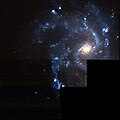NGC 5468
| NGC 5468 | |
|---|---|
 NGC 5468 by Hubble Space Telescope | |
| Observation data (J2000 epoch) | |
| Constellation | Virgo |
| Right ascension | 14h 06m 34.9s[1] |
| Declination | −05° 27′ 11″[1] |
| Redshift | 0.009480 ± 0.000013[1] |
| Helio radial velocity | 2,842 ± 4 km/s[1] |
| Distance | 138 ± 22.7 Mly (42.5 ± 7.0 Mpc)[1] |
| Apparent magnitude (V) | 12.5[2] |
| Characteristics | |
| Type | SAB(rs)cd[1] |
| Apparent size (V) | 2′.6 × 2′.4[1] |
| Other designations | |
| UGCA 384, MCG -01-36-007, PGC 50323[1] | |
NGC 5468 is an intermediate spiral galaxy located in the constellation Virgo. It is located at a distance of about 140 million light-years from Earth, which, given its apparent dimensions, means that NGC 5468 is about 110,000 light-years across. It was discovered by William Herschel on March 5, 1785.[3]
NGC 5468 has been home to five supernovae spotted in the last 20 years, (meaning they occurred at least 140 million years ago): SN 1999cp (type Ia, mag. 18.2), SN 2002cr (type Ia, mag. 16.5), SN 2002ed (type IIP, mag. 16.5), SN 2005P (type Ia-pec, mag. 18.1), and SN 2018dfg (type IIb).[4][5] NGC 5468 is seen face-on. The spiral pattern is open. The two principal arms emanate from a small bar and start to branch into several thin fragments after a half the one-and-a-quarter revolution the other. In the images of the Carnegie Atlas of Galaxies can be seen three large H II regions and some fainter ones.[6] These regions feature intense star formation. SN 2005P was located at the edge of one of these regions.[7]
NGC 5468 forms a non-interacting pair with , which lies at a projected distance of 5.1 arcminutes. NGC 5468 belongs to the NGC 5493 galaxy group. Other members of the group are the interacting pair Arp 271 (NGC 5426 and NGC 5427), , and .[8]
Gallery[]

NGC 5468 by the HST
References[]
- ^ a b c d e f g h "NASA/IPAC Extragalactic Database". Results for NGC 5468. Retrieved 2016-01-18.
- ^ "Revised NGC Data for NGC 5468". spider.seds.org. Retrieved 25 November 2018.
- ^ Seligman, Courtney. "NGC 5468 (= PGC 50323)". Celestial Atlas. Retrieved 19 November 2018.
- ^ List of Supernovae IAU Central Bureau for Astronomical Telegrams. Retrieved 29 December 2015.
- ^ "Bright Supernova pages - Most prolific galaxies". www.rochesterastronomy.org.
- ^ Sandage, A., Bedke, J. (1994), The Carnegie Atlas of Galaxies. Volume I, Carnegie Institution of Washington
- ^ Lyman, J. D.; James, P. A.; Perets, H. B.; Anderson, J. P.; Gal-Yam, A.; Mazzali, P.; Percival, S. M. (September 2013). "Environment-derived constraints on the progenitors of low-luminosity Type I supernovae". Monthly Notices of the Royal Astronomical Society. 434 (1): 527–541. arXiv:1306.2474. Bibcode:2013MNRAS.434..527L. doi:10.1093/mnras/stt1038.
- ^ Makarov, Dmitry; Karachentsev, Igor (21 April 2011). "Galaxy groups and clouds in the local (z∼ 0.01) Universe". Monthly Notices of the Royal Astronomical Society. 412 (4): 2498–2520. arXiv:1011.6277. Bibcode:2011MNRAS.412.2498M. doi:10.1111/j.1365-2966.2010.18071.x. S2CID 119194025.
External links[]
 Media related to NGC 5468 at Wikimedia Commons
Media related to NGC 5468 at Wikimedia Commons- NGC 5468 on WikiSky: DSS2, SDSS, GALEX, IRAS, Hydrogen α, X-Ray, Astrophoto, Sky Map, Articles and images
- Intermediate spiral galaxies
- Virgo (constellation)
- NGC objects
- UGCA objects
- Principal Galaxies Catalogue objects
- Astronomical objects discovered in 1785
- Discoveries by William Herschel
